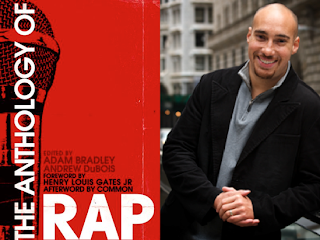Thursday, October 27, 2011
The Anthology of Rap: Adam Bradley, Andrew DuBois, editors
The Anthology of Rap
Adam Bradley, Andrew DuBois, editors
Yale University Press
$25.00
Review by Rene Schwiesow
I know, long ago you wrote off Rap as a musical movement that had only minor impact. Perhaps that was at its inception during the 70’s or, perhaps, more recent than that. Rap, however, has clearly had an influence on both music and poetry and “The Anthology of Rap” is here to show you exactly why. Many of us bemoan the fact that kids these days do not appreciate the poetics of poetry. We discuss alliteration, rhyme, metaphor, and allegory at length; and we believe that young people have little interest in understanding their use.
I have a number of young people as friends on facebook. Very often the status they display is a line or two from a song. On occasion they break into a thread of discussion regarding those lyrics. They may not discuss the poetry as the older generation does, but they certainly do discuss it. Rap music and the hip-hop culture have gone a long way toward creating and inspiring an interest in poetry. Rap’s poetic form contains organized verses, generally sixteen lines in length and rhyme is a distinctive feature. Rhyme in Rap is used full, slant, monosyllabic, and multisyllabic. Rappers use their rhyme both at the end of lines and within the lines of their poetry. And you thought they were simply throwing words together without clear poetic intention.
The anthology is broken into three parts: Old School Rap, 1978-1984; The Golden Age, 1985-1992; and Rap Goes Mainstream, 1993-1999. Each section includes Rap musicians whose names have become household words. Artists such as Ice-T, Busta Rhymes, Ice Cube, Lauren Hill, Snoop Dogg, 2Pac, Eminem, Lil Wayne, and Kanye West are well-known on the music scene and their work has had great impact within our world.
When I showed my 21-year-old son the anthology he was delighted to see that Rap was being given credence in a literary context. As he opened the book to browse through the artists, Lil’ Kim jumped out at him and he smiled broadly – “I love Lil’ Kim,” he said. He added that he felt she was misunderstood. The anthology agrees. In a world where documentaries like the new film “Miss Representation” question the way in which society views females, Lil’ Kim’s hardcore, sexual, erotic lyrics have drawn criticism. Lil’ Kim and many of her listeners, however, understand that her lyrics are “radical acts of female empowerment.”
Queen Latifah holds a prominent place in Rap’s Golden Age. I was fortunate enough to meet Queen Latifah in San Francisco during the early 90’s and I have to agree with the anthology’s description of her “dignified demeanor and commanding presence.” She is known for lyrics such as “Evil that Men Do,” a gender disparity in structural poverty piece.
Tell me don’t you think it’s a shame
When someone could put a quarter in a video game
But when a homeless person approaches you on the street
You can’t treat him the same?
It’s time to teach the deaf, the dumb, the blind
That black-on-black crime only shackles and binds
You to a doom, a fate worse than death
But there’s still time left
To stop putting your conscience on cease
And bring about some type of peace. . .
And then there is Eminem. 50-Cent said, “Eminem was made for hip-hop.” In 2002 Eminem starred in the movie 8 Mile. My son was then 12 years old and begged me to allow him to see the movie. He had just received a new Eminem CD, the cleaned up version, and he was taken with his lyrical ability. I may never have seen 8 Mile if it weren’t for my son’s begging, so I went to the theater by myself to see the movie first – and much to my surprise I was amazed at the way in which the poetry of the rappers was brought to life. While Rap was created by the brown and black skinned, the white-skinned Eminem was becoming known and highly respected for his lyrical skill. He plays with persona and is known as three distinct personalities: Eminem, Slim Shady, and Marshall Mathers.
This is lyrical combat – gentlemen, hold your pistols
And since birth I’ve been cursed with this curse to just curse
And just to blurt this berserk and bizarre shit that works
And it sells and it helps in itself to relieve
All this tension dispensin these sentences, getting this
Stress that’s been eatin me recently off of this chest
And I rest again peacefully (peacefully). . .
And more:
And I just do not got the patience (got the patience). . .
To deal with these cocky Caucasians who think
I’m some wigger who just tries to be Black ‘cause I talk
With an accent. . .
“The Anthology of Rap” is considered a landmark text. Rap, hip-hop, is more than just a phase, a passing fad. Rap is now a permanent part of our world culture. Rap is the words that the artists employ and those words reach deep, go far, and make statements that have the power to rock foundations. In the afterward, Chuck D states this about Rap: “For me, it taught different spiritualities, different aspects of culture and history, different languages and modes of speech. I hope this book will help more people get back to that.”
A worthy read for those who wish to expand their poetic horizons and to understand a genre that has lent itself to people for decades now, a genre that has no intention of fading away.
Subscribe to:
Post Comments (Atom)




































No comments:
Post a Comment